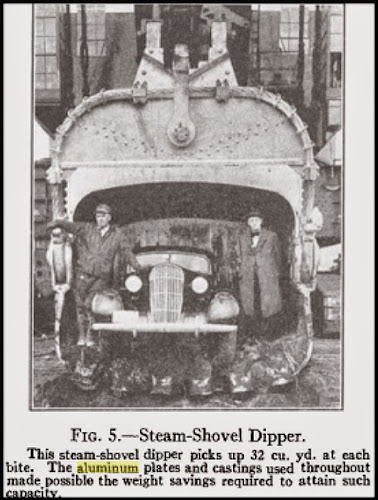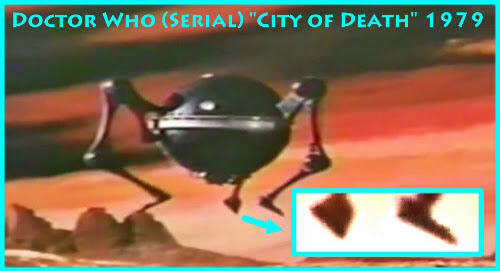Let me tell you a story about Aluminum, and an impossible artifact. The details differ slightly from story to story, but in either 1973 or 1974 a 5 pound "wedge" showing signs of extreme wear and corrosion - was found either on the banks of the Mures river, or in a sand pit, or both. The snaking Mures river defines the small town of Auid in present-day Romania.
Workers were digging as part of a construction project and found the "wedge" along with two Mastodon bones under 35 feet of sand - meaning that the "wedge" was assumed to be at least 11,000 years old. The thickness of the oxide layer supposedly indicated that the object was anywhere from hundreds to millions of years old, depending on the report. And it was Aluminum.

There are two holes that intersect and two 'horns' at the flat end of the wedge that would either lock or articulate with some further piece. It is slightly over 8 inches in its largest dimension. One wedge face and two sides show signs of either tool marks or wear. According to postings, the Wedge was donated to the Museum of the History of Transylvania. The story was later broken in 1995. RUFOR, a Romanian UFO magazine, published a piece after Florian Gheorghita rediscovered the wedge. It was tested at the "Archeological Institute of Cluj-Napoca" and a Swiss lab. Gheorghita further asked a series of professionals to examine the artifact, and claims that an aeronautical engineer identified the wedge as a piece of landing gear on a VTOL-type (Vertical Take-Off and Landing) craft.

The metallurgical tests on the wedge all demonstrated the same elemental makeup:
- 89 percent aluminum,
- 6.2 percent copper,
- 2.84 percent silicon,
- 1.81 percent zinc,
- 0.41 percent lead,
- 0.33 percent tin,
- 0.2 percent zirconium,
- 0.11 percent cadmium,
- 0.0024 percent nickel,
- 0.0023 percent cobalt,
- 0.0003 percent bismuth,
- trace of galium.
None of these elements are rare to the earth, and all (except gallium, which is almost impossible to completely remove from aluminum) are used in creating a near-infinite variety of aluminum alloys. It is the thickness of the oxidation, and primarily the depth at which the wedge was found "with Mastodon bones", which make things interesting. If earlier cultures could not make Aluminum, who did?
The first question, the most important question, must be asked: is this alloy found on earth? And what are its characteristics? The primary three elements of the Wedge are Aluminum, Copper, Silicon (Al-Cu-Si) and while alloys of Aluminum are myriad, Al-Cu-Si alloys are the most popular in use for casting where high strength is required. Bismuth, lead and cadmium are added to increase machinability.
This alloy is clearly part of the 2000 series of Aluminum, where copper adds higher strength, and silicon increases toughness and imparts increased integrity to the casting process where complex parts are involved. When heat-treated, this alloy can exceed the toughness of mild steel. Interestingly though, manufacturers note that the most common applications for the 2000 series Aluminum alloys are aerospace, military vehicles and rocket fins.
Copper in aluminum alloy tends to segregate to grain boundaries, causing local galvanic potentials and increased pitting. In other words, Al-Cu-Si tends to have the lowest corrosion resistance of any Aluminum alloy - meaning that the layer of corrosion may not give an accurate estimate of age.
The facts, as they stand, are used to assert that Aliens or Time Travellers (or Time Travelling Aliens, perhaps in a blue box) had somehow left a piece of their craft behind in Romania. Because not only was the Aluminum an Out Of Place Artifact ("OOPART") by virtue of the material pre-dating its known manufacture on earth - but said to be part of a flying craft by an engineer. To assess these assertions, a little more needs to be said about Aluminum.
Aluminum itself is a somewhat ironic element (especially since it is lucky atomic number 13) - in that it is the most abundant metal in the earth's crust and third most abundant element after oxygen and silicon, yet it was not discovered and named as an element until 1761. Aluminum was first produced in 1825 and not in mass quantities until 1886 using the Hall–Héroult process of electrolysing a molten cryolite bath. Up until this point, Aluminum was worth more than gold due to the expense of the process and materials needed. Even in present day, the cost of Aluminum is largely due to the huge amount of energy required to first smelt bauxite and then electrolyse the resulting Aloxite at 1000 Degrees C. It is estimated that 8% of the United States annual energy consumption is used for the production of Aluminum. The point here is simple - Aluminum is very hard to isolate. (And you should always recycle your aluminum cans!). Previous to 1825, metallic Aluminum effectively did not exist. It was not simply forgotten like the formula for concrete or Damascus steel - it never was.
But could ancient cultures have found a way to produce Aluminum, as they had steel? Or are there any naturally occurring pure forms of Aluminum that could be taken advantage of, as there are native forms of gold, silver, or copper? (With the exception of Rubies, Sapphires, and Corundum which are all forms of Aluminum Oxide)
The first question is the easiest to answer - there are no other verified ancient artifacts made of metallic aluminum, whether coins, crowns, or hammers. But as far as the second question goes, there are peer reviewed papers that report "native aluminum" being found in exotic locals - which means that Aluminum is now accepted by geologists as a mineral. They are always associated with extreme, oxygen free environments such as ocean floor cold seeps or volcanic action. These aluminum flakes are always minuscule (2 mm x 2 mm by .5 mm, for example) and do not add up to a sizeable amount of aluminium - certainly, if 5 lbs of this metal was recovered 11,000 years ago, it would not have been made into a hammer - it would be the crown of crowns. Even 150 years ago, Aluminum had a higher value than platinum or gold.
 |
| Excavator Bucket Teeth |
So, Aluminum occurs naturally on earth. Ancient cultures could not isolate it. Does this leave the Alien/ Time Traveller hypothesis as the most likely scenario? The shape of the wedge and holes are unremarkable and certainly not "Alien". And the estimated age of the artifact is in doubt, because of the susceptibility of this particular alloy to corrosion. Let's assume that the artifact was found at the bottom of the excavation, and not simply planted by hoaxers. How did it get there? It is the location that the Wedge was found in that provides the last clue. Is there anything earthly that high-strength aluminum is used for; created in a similar shape; and could be found at the bottom of an excavation - no matter how deep.
 |
| Excavator Bucket Teeth and adapter pieces. |
Spending some time on a Google image search (and my own experience finding similar "artifacts" in the course of my job at construction sites) a solution becomes apparent. Excavator Bucket Teeth (EBT) bare a striking resemblance to the Wedge of Aiud. They are used to both protect the expensive digging bucket from damage, and increase the efficiency of the operation. Many look very similar, although none match exactly the Wedge's profile, which isn't unusual since technology has advanced forty years since the wedge was found. Generally they are made of carbon steel, which makes them an unlikely answer to this puzzle. Unless they are also made of Aluminum. And are they?

Aluminum (as well as Brass, Stainless Steel, Iron, Zinc Alloy or Polyurethane) EBT can be purchased on-line from Global Sources in China, complete with a 30 day delivery schedule. They are used to reduce the risk of explosion and fire when digging in volatile environments - such as coal mines, swamps, land fills or around inflammable gases or vapours. And while the total number of volatile environments in Romania cannot be estimated - coal mining itself has been going on in Romania for some time. Many mines have been shut down in recent years due to the fall of Communism and joining the European Union (EU). So is it far fetched to suggest that an excavator - that had been used in coal mining or the transfer of coal - was used in excavating the sand in this riverbank/ sandpit? And of all likely scenarios, did the Aluminum wedge/ tooth simply fall off of the excavator bucket that was digging the hole? And then someone unfamiliar with the maintenance of the excavator found it in the sand.
 |
| Present coal mining zones in Romania. |
Sources:
Corrosion Resistance of Aluminum and Magnesium Alloys: Understanding ... By Edward Ghali
http://eurekamag.com/research/037/014/037014831.php
http://www.thelivingmoon.com/46ats_members/Lisa2012/03files/Object_Made_of_Aluminum_from_Aiud.html
http://s8int.com/page29.html
http://www.globalsources.com/si/AS/Ste-Superior/6008848006949/pdtl/Excavator-bucket-teeth/1079838854.htm
http://www.euracoal.org/componenten/download.php?filedata=1319015142.pdf&filename=Romania%20map%202011.pdf&mimetype=application/pdf
Journal of Asian Earth Sciences. 2011 | 40 | 1 | 363-370: Characteristics and possible origin of native aluminum in cold seep sediments from the northeastern South China Sea. By Zhong Chen , Chi-Yue Huang , Meixun Zhao , Wen Yan , Chih-Wei Chien , Muhong Chen , Huaping Yang , Hideaki Machiyama , Saulwood Lin









